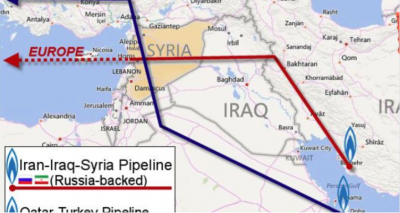Syria Resurrects Proposed Pipeline for Iranian Gas to Reach European Markets

All Global Research articles can be read in 27 languages by activating the “Translate Website” drop down menu on the top banner of our home page (Desktop version).
***
The Nord, Blue, Turk, Yamal and South Streams, as well as NordStream 2, are non-aligned pipelines that bring Russian gas to Europe while also cutting out U.S. interests. But along with NordStream 2, the pipeline that will also bring immense frustration to U.S. policymakers if it comes to fruition is the so-called “Islamic Pipeline” as it will bring Iranian gas to Europe via Iraq and Syria.
Although called the “Islamic Pipeline” in the West, it is often called the “Friendship Pipeline” between Iran, Iraq and Syria. This project seemed dead after Syria was devasted by the continuing war that even spilled over into Iraq. This is in addition to all the sanctions levelled against Iran. However, just recently, the Syrian Minister of Electricity, Ghassan al-Zamil, said that the project is not abandoned at all.
Zamil noted that the production of electricity has seriously decreased in Syria from 14 million cubic meters to 8.5 due to sanctions and the reduction of imported gas needed for power plants. Syria currently produces 2,700 megawatts of electricity. This is nowhere near enough to meet the needs of the country, which is why Zamil is resurrecting the thought-to-be dead pipeline project as it can help Syria reach 5,000 megawatts of electricity.
The first Memorandum of Understanding was signed in 2011, just as the Syrian War was beginning. In 2012, just as the war was intensifying, the Iranian, Iraqi and Syrian oil ministers signed a formal agreement to bring Iranian gas through their countries to reach Lebanon’s Mediterranean coast and, from there, onwards to Europe. From Washington’s perspective, the fact that Iranian energy could reach European markets is a major problem, especially as it hinders the proposed Qatar-Turkey Pipeline that has U.S support. The Qatar-Turkey pipeline was supposed to carry Qatari gas to Turkey via Saudi Arabia, Jordan and Syria. Once in Turkey, it would then connect with the Trans Adriatic Pipeline (TAP) that carries Azerbaijani gas to Europe.
The Qatar-Turkey and Friendship pipelines would lessen Europe’s reliance on Russian gas. However, replacing Russian gas for Iranian is equally detrimental to Washington’s goal of pressuring these countries into submission. The decision by Syrian President Bashar al-Assad to choose the Iranian pipeline instead of the Qatar-Turkey pipeline was a major reason in motivating Saudi Arabia, Qatar, Turkey and the U.S. to back radical jihadist groups in the now war-torn country.
Washington cannot accept an Iran, that is encircled, sanctioned and in every way pressured, come out triumphant with a gas pipeline that can reach European markets. But on the other hand, every effort to topple Assad in Syria and the Mullahs in Iran, besides a direct invasion, has been tried, exhausted and failed, so there is not much else the U.S. can do to prevent the construction of the pipeline.
The re-emergence of plans to build the Friendship Pipeline might also explain why Greece became one of the first NATO and European Union members to restart its relations with Syria after withdrawing from the country in 2012, and why Greek Foreign Minister Nikos Dendias visited Iraq last October, met the Iraqi Foreign Minister earlier this month in Athens, and plans to do a tour this year of Baghdad, Basra and Erbil – pending the COVID-19 and security situation. Although Turkey was seen as the gateway for Eastern energy to reach European markets, Greece has challenged this assertion by becoming an energy hub itself.
Syria is unlikely to accept a pipeline continuing into Turkey considering it is occupying large swathes of the country and is the main backer and funder of jihadist groups fighting against the national army. This means that inevitably the Friendship Pipeline must pass through Cyprus and Greece to reach European markets. This would be in addition to the East Med Pipeline that will connect Israeli and Cypriot gas to European markets via Greece, the TAP pipeline that transports Azerbaijani gas to Europe via Turkey, Greece, Albania and Italy, the proposed Tesla pipeline to connect the TurkStream with Central Europe via Greece, North Macedonia and Serbia, the Gas Interconnector Greece-Bulgaria and the proposed North Macedonia–Greece Interconnector Gas Pipeline.
If all the proposed pipelines come to fruition, Russian, Azerbaijani, Iranian, Cypriot and Israeli gas would all pass-through Greece before reaching their next destination, making the country a true energy hub. It must also be considered that Greece has vast gas deposits in the Eastern Mediterranean that it is yet to exploit. Turning Greece into an energy hub does not hinder on the Friendship Pipeline, but it would certainly consolidate its newfound status.
Zamil appears confident that the pipeline can be built despite Turkey occupying northern Syria and U.S.-backed separatists controlling areas east of the Euphrates River. On top of the occupation zones, ISIS still has a haunting presence in the Syrian dessert. However, the biggest problem facing the Friendship Pipeline is whether Europe is willing to circumvent U.S. sanctions against Iran and Syria. It is for this reason that the success of NordStream 2 could pave the way for the success of the Friendship Pipeline, and another major reason why Washington has been threatening Germany with sanctions for willingly building a pipeline to bring Russian gas to Europe.
*
Note to readers: please click the share buttons above or below. Forward this article to your email lists. Crosspost on your blog site, internet forums. etc.
This article was originally published on InfoBrics.
Paul Antonopoulos is an independent geopolitical analyst.
Featured image is from InfoBrics

